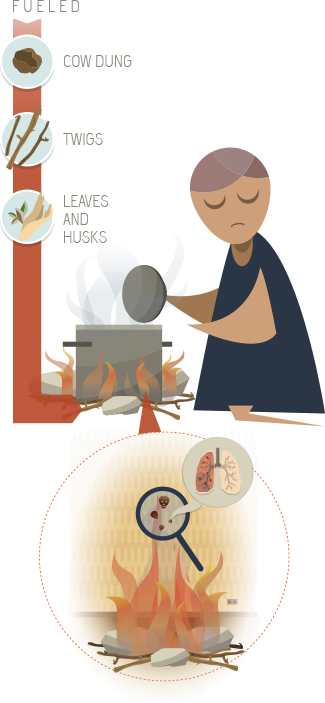
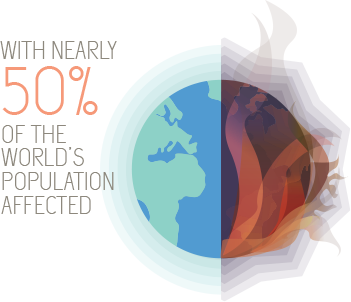

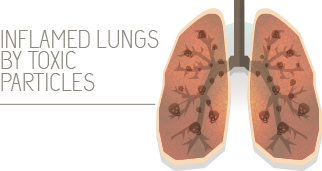

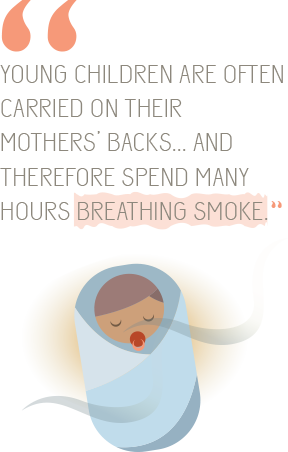
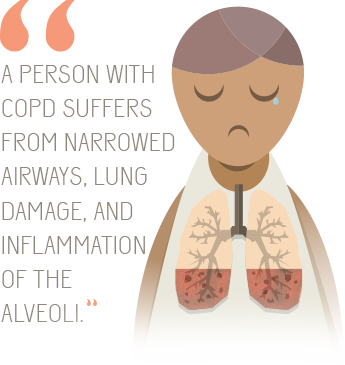
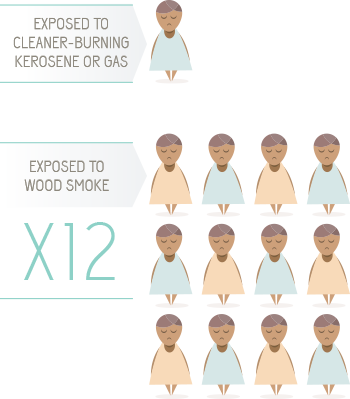
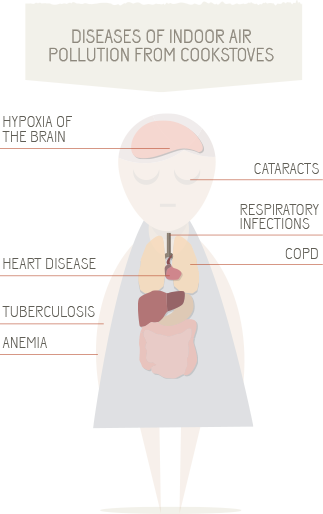

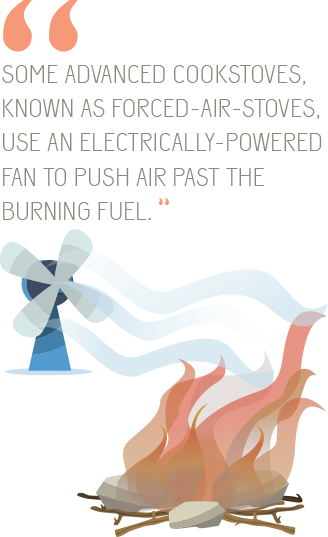
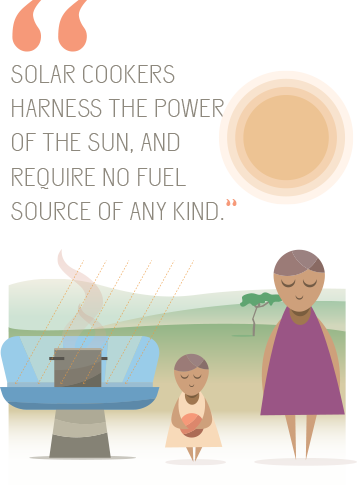
With Every Breath
As you read this, a mother in rural Africa, India, or China is preparing a meal for her family. This is a daily ritual that has been passed on from generation to generation and will continue to be repeated for many decades of her life as well as her children’s lives. Her stove consists of three large rocks arranged on the floor of her home. In the middle of them, a fire burns, fueled by gathered twigs or dung from their cows, or perhaps even leaves and husks left over from harvested crops.
Smoke rises from the burning fuel as she sets a pot of meat or vegetables atop the open flame. The silent killer creeps to every corner of their home with nowhere to escape. Her eyes begin to sting from the fumes, becoming dry and reddened, and she finds it difficult to see clearly through the smoke. Her baby girl, resting in a carrier on her back, inhales the smoke and is wracked by a spasm of hacking coughs. Later, her son may study and do his schoolwork by firelight. His throat will begin to tighten with each new breath he takes of the dark smoke that still lingers in the home. Even later, when the family sits around the fire for warmth, the airborne dirt and debris will drift and settle into their airways leaving their bodies to fight for each drop of clean air to reap from the toxic gas they constantly inhale.
With every passing day, more soot is deposited on the inside of their home – microscopic, blackened particles that will continue to enter their lungs even when the fire has burned out. Her children will be exposed to this pollution from birth onwards, just as she and her husband were, and they will grow up to use the very same indoor cooking methods, passing on this toxic tradition to the next generation.
For most of us, it would be unthinkable to start a poorly-ventilated open fire in the middle of our homes and keep it burning for hours every day. Yet this one family's daily life is a harsh reality for three billion people in the developing world who simply have no alternatives. Up to 90% of households in these rural areas rely on these stoves. For them, these basic cookstoves are an essential tool, providing them with light, warmth, and heat to cook their meals. But this same life-giving tool, crucial to sustaining their communities, comes with a death toll of millions every year. Day by day, it is poisoning them with every breath.
A Global Poison
The overall health impact of these unsafe household cookstoves is almost impossible to imagine. This daily exposure to indoor smoke and pollution affects 42% of the world's population, such as families in underdeveloped areas of Asia, Africa, the Mediterranean, South America, and island nations around the globe.
For up to seven hours a day, almost as long as a standard workday, families are exposed to toxic chemicals and dangerous particles emitted by the burning of biomass – wood, dung, agricultural waste and coal. These byproducts include fine soot particles, small enough to build up in the microscopic structures of the lungs and block them from transporting oxygen into the blood. They're also inhaling carbon monoxide, a gas so deadly that our homes have alarms to warn of its presence, which further inhibits the oxygen content in their bloodstream. These families are being slowly suffocated over their lifetimes.
Toxic benzene, a known carcinogen, enters the air from burning wood, and is then deposited along their airways. Hydrocarbons are released from the fire, inflaming their lungs and impacting their brain and nervous system. The nitrogen oxide given off by the burning fuel combines with moisture in the air to form nitric acid vapor, eating away at their lung tissue. Dozens of similarly dangerous chemical byproducts are created by these basic cookstoves, which often exist in homes unequipped with proper ventilation to rid the indoor space of the lethal mist.
Just how bad is the problem? Airborne particles smaller than 10 micrometers – 1/100th of a millimeter, or about one-tenth the width of a human hair – are known as PM10, and these particles are small enough to accumulate in the alveoli, the parts of the lungs which bring oxygen into the blood while removing carbon dioxide. The World Health Organization (WHO) has recommended a daily average limit for exposure to PM10 of 50 micrograms per cubic meter. However, in homes with unsafe cookstoves, the average concentration of PM10 can range up to 5,000 micrograms per cubic meter. In the area closest to the fire, the concentration of PM10 can reach an extraordinarily unhealthy 50,000 micrograms per cubic meter – a stunning 100,000% of the WHO's recommended limits. These are the massive amounts of pollutants that billions of people around the world inhale every day.
Suffocating Their Future
What are these incredible quantities of pollutants doing to their bodies? Fine soot particles are responsible for most of the damage to their health, and along with other toxic emissions, they cause a variety of serious illnesses. Women and children are the most severely impacted, as women are most frequently the ones to use these cookstoves, and their young children often stay in the home with them.
Chronic obstructive pulmonary disease, or COPD, is a condition encompassing emphysema and chronic bronchitis. A person with COPD suffers from narrowed airways, lung damage, and inflammation of the alveoli. This reduces the surface area of the lung exposed to the air, meaning that the person can no longer efficiently exchange oxygen and carbon dioxide when breathing. As of 2010, COPD affects about 329 million people around the world, and within 15 years, it could become the fourth most common cause of death in the world. In a study of women in rural Turkey, burning biomass used in unsafe cookstoves was found to account for 23% of cases of COPD. Women who use unsafe biomass fuels in their cookstoves have a threefold greater risk of developing COPD than women who use cleaner fuels. Studies of guinea pigs and rats also showed that exposure to wood smoke for a few hours a day over three months was enough to cause mild emphysema.
Acute lower respiratory infections, or ALRIs, are the largest cause of mortality in children under five, resulting in over 2 million deaths per year among this age group. ALRIs include pneumonia, bronchitis, and lung abscesses. Half of deaths from ALRIs among children under five are due to indoor air pollution caused by unsafe cookstoves, and young children in homes using biomass fuels have a two to three times greater risk of contracting an ALRI. In a study in Nigeria, children with ALRIs who were exposed to wood smoke at home were 12 times more likely to die of their disease than children from homes using cleaner-burning kerosene or gas. A study of homes in Guatemala also found that when indoor pollution was cut in half using chimneys, the occurrence of severe pneumonia in children was reduced.
In addition to pneumonia and bronchitis, exposure to smoke from unsafe cookstoves has been implicated in low birth weight, which places children at greater risk of slowed growth, cognitive deficits, childhood illness, chronic diseases, and death. These pollutants have also been associated with anemia and nutritional deficiency.
For adults, smoke exposure has also been tied to the development of lung cancer, a higher incidence of tuberculosis, cardiovascular disease, and cataracts. The International Agency for Research on Cancer has classified biomass smoke as a probable carcinogen, and coal smoke as carcinogenic in humans. In developing nations, it may be almost impossible to access the advanced medical care needed to treat these serious diseases.
Altogether, indoor air pollution from cookstoves is responsible for 4% of the total worldwide disease burden, and causes 4 million premature deaths every year – one every eight seconds. This is equivalent to the entire population of Montana dying four times over, year in and year out – or half the population of New York City. If this many people were dying every year in the first world, it would be seen as an international emergency. This is the unthinkable, deadly impact of something as simple as three stones and a fire.
Solutions Within Our Grasp
Clean and safe home cooking is a solved problem – we know which technology is needed to prevent the release of pollutants in our homes. The challenge lies in providing simple and affordable versions of these safe stoves to developing nations, where electricity and clean fuels may be in short supply, and users of these stoves may not have the knowledge or equipment to repair and maintain them.
Soot particles, the greatest hazard arising from the use of biomass fuels, are mainly the result of incomplete combustion of these fuels. When crop waste, wood, charcoal and dung are not fully burned, the remaining particles enter the air in massive quantities, creating dangerous pollution.
Fortunately, even biomass fuels can be used with greater safety through advanced biomass cookstoves, which are more efficient and reduce indoor air pollution. Some advanced cookstoves, known as forced-air-stoves, use an electrically-powered fan to push air past the burning fuel. This results in much more complete combustion of the biomass fuels, reducing the amount of particulate matter released into the home. Another type of biomass cookstove reroutes the fire's smoke back toward the flame, ensuring that the unhealthy particles present in the emissions are more completely incinerated. These advanced cookstoves can also use more efficient processed pellets of compressed biomass, ultimately reducing fuel use by up to 67% – and a reduction in fuel used means a reduction in pollution released into the home.
As a replacement for biomass fuels, clean cookstoves can use a variety of different fuels and power sources which emit less pollution. Alcohol cookstoves use ethanol or methanol in liquid or solid forms, and these fuels burn very cleanly, producing far less carbon monoxide than other fuels. The use of alcohol fuels can lead to vastly decreased indoor air pollution.
Families can also use home biogas plants to process animal manure and human waste into methane gas, which greatly limits smoke emissions when used as a cooking fuel, reducing the incidence of respiratory conditions. Propane (liquefied petroleum gas, or LPG), provided in canisters, is a very clean-burning alternative to open fires: compared to biomass fuels, the weight of fuel needed is reduced by 90% when propane is used, and the pollution produced decreases by 95%. And electric stoves produce no polluting emissions or smoke, instead using electrical current for direct heating.
Another form of stove, known as a retained heat cooker, passively insulates a pot of food after it's been removed from the heat source, trapping the heat and allowing the food to cook by simmering for several hours. This provides for the sustained cooking of food, without the need to use an unsafe cookstove for several additional hours every day.
Solar cookers harness the power of the sun, and require no fuel source of any kind. By reflecting the sun's rays and concentrating all of the light on a small area, these cookers can trap and focus enough heat to serve as a replacement for traditional, fuel-burning cookstoves. Because they use no fuel, they also create no emissions or pollution.
A number of design improvements to cookstoves, as well as the homes using them, are also possible. Chimneys can vent a significant portion of fire emissions to the outside of the house, and the simple addition of open windows to the kitchen or cooking area can improve air circulation and ventilation.
All of these technologies are potentially viable possibilities for the replacement of unsafe cookstoves, but many communities in developing nations may lack the resources needed to start using these safer cookstoves on a permanent basis. In many impoverished rural and urban areas, electricity and cleaner fuels may be hard to come by, and cookstove users require training in how to use more advanced stoves.
Increased adoption of cleaner cookstove technologies must be driven by a demand, built up by educating families on the dangers of unsafe cookstoves, and providing them with these newer stoves. The initial cost of one cookstove can range from $15 to $150, depending on the type of stove, and this may be out of reach for many families.
But there is hope, and you can help to give these families that hope. The Global Alliance for Clean Cookstoves is a public-private partnership pushing for the adoption of cleaner cookstoves around the world. With even a modest donation, you can give these families the gift of health, life, and a brighter future for their children. The suffocating effects of indoor air pollution don't have to be a fact of life anymore – and you can be the one to give them room to breathe.
Sources:- http://www.who.int/mediacentre/factsheets/fs292/enc
- http://www.cleancookstoves.org/our-work
- http://www.cleancookstoves.org/resources/fact-sheets/cookstoves-and-women-1.pdf
- http://www.slideshare.net/IHME/gbd-2010-press-conference
- http://www.who.int/bulletin/archives/78(9)1078.pdf
- http://www.healthmetricsandevaluation.org/gbd/visualizations/gbd-2010-leading-causes-and-risks-region-heat-map
- http://www.cleancookstoves.org/resources/fact-sheets/new-cookstoves-general-onepager-1.pdf
- http://ehs.sph.berkeley.edu/krsmith/publications/02_smith_1.pdf
- http://www.ncbi.nlm.nih.gov/pmc/articles/PMC2568866/?report=printable
- http://www.cleancookstoves.org/our-work/the-solutions/behavrioal-structural.html
- http://www.nbci.nlm.nih.gov/pmc/articles/PMC3346782
- http://www.cleancookstoves.org/our-work/transformation-strategies
